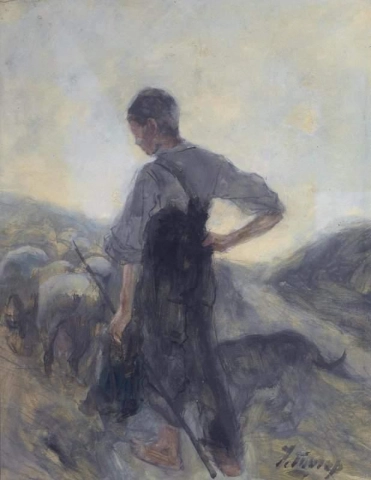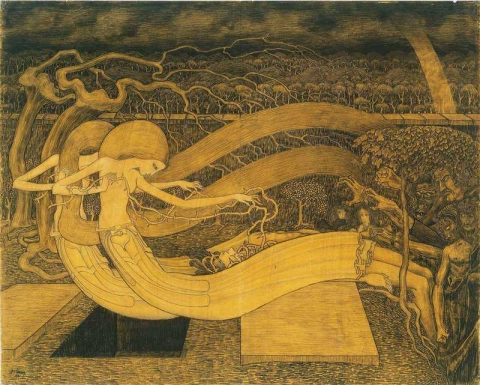

Hand painted reproductions of Jan Toorop
Jan Toorop: Visionary of Symbolism and Art Nouveau
Early Life and Artistic Development
Jan Toorop (1858–1928) was a Dutch-Indonesian painter known for his distinctive contributions to Symbolism and Art Nouveau. Born in Purworejo, Java, in the Dutch East Indies (now Indonesia), Toorop's multicultural upbringing deeply influenced his artistic vision. In 1869, he moved with his family to the Netherlands, where he later pursued formal training at the Royal Academy of Fine Arts in Amsterdam and the Académie Royale des Beaux-Arts in Brussels.
During his early career, Toorop experimented with a variety of styles, including Impressionism and Pointillism. However, it was his exposure to Symbolist circles in Paris and Brussels that would define his artistic identity. He became associated with the avant-garde group Les Vingt in Brussels, which connected him with leading Symbolist and Art Nouveau artists of the time.
Style and Influence
Jan Toorop’s style is a unique fusion of Symbolism, Art Nouveau, and his Javanese heritage. His artworks often feature intricate, sinuous lines, flowing organic forms, and highly stylized figures. Toorop’s Symbolist works delve into themes of mysticism, spirituality, and the human condition, often imbued with a sense of otherworldly beauty and emotional depth.
One of his most iconic works, The Three Brides (1893), exemplifies his Symbolist vision. The painting portrays three ethereal female figures, each representing different stages of life and spiritual states, surrounded by ornate, flowing patterns that evoke both Art Nouveau aesthetics and traditional Javanese motifs.
Toorop's influence extends beyond Symbolism into the realms of graphic design and poster art. His decorative style, characterized by elegant, curvilinear forms, made him a prominent figure in the Art Nouveau movement, particularly in the Netherlands, where he designed posters, book covers, and stained glass windows.
Legacy and Enduring Recognition
Jan Toorop's visionary art bridged the cultural and artistic worlds of Europe and Southeast Asia, making him a significant figure in the international Symbolist and Art Nouveau movements. His works are celebrated for their intricate beauty, spiritual symbolism, and cross-cultural richness.
Today, Toorop’s paintings and graphic designs are held in high regard and can be found in prestigious museums and private collections worldwide, including the Rijksmuseum in Amsterdam and the Kröller-Müller Museum. His legacy continues to inspire contemporary artists and designers, and his work remains a testament to the power of art to transcend cultural boundaries and explore the depths of human experience.
Own a Handcrafted Oil Painting Reproduction of Jan Toorop’s Masterpieces
Bring the mysticism and elegance of Jan Toorop’s art into your home with our handmade oil painting reproductions on canvas. Each piece is meticulously crafted to capture the intricate details, flowing lines, and symbolic depth of Toorop’s original works. Experience the beauty and spirituality of Symbolist art and make Toorop’s visionary legacy a part of your collection.
Imagine owning an original-style painting by one of the greatest artists in history. At POD, we offer you the chance to make this dream a reality. Each canvas is faithfully reproduced down to the smallest detail, allowing you to experience the beauty of the artist’s vision in your own home.
Our reproductions are crafted by experienced painters using the finest materials and time-honored methods. We are committed to delivering works of exceptional quality that will inspire and bring joy to your family for generations to come.






































